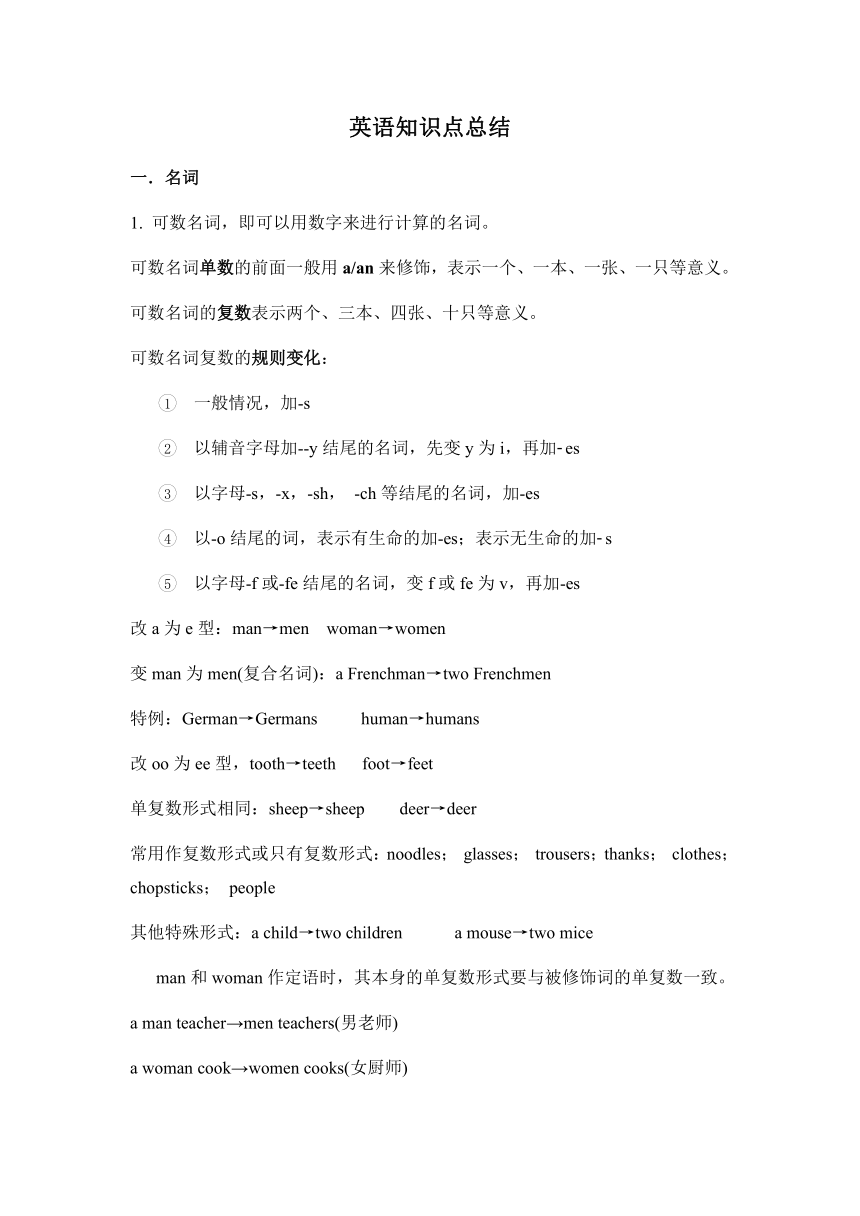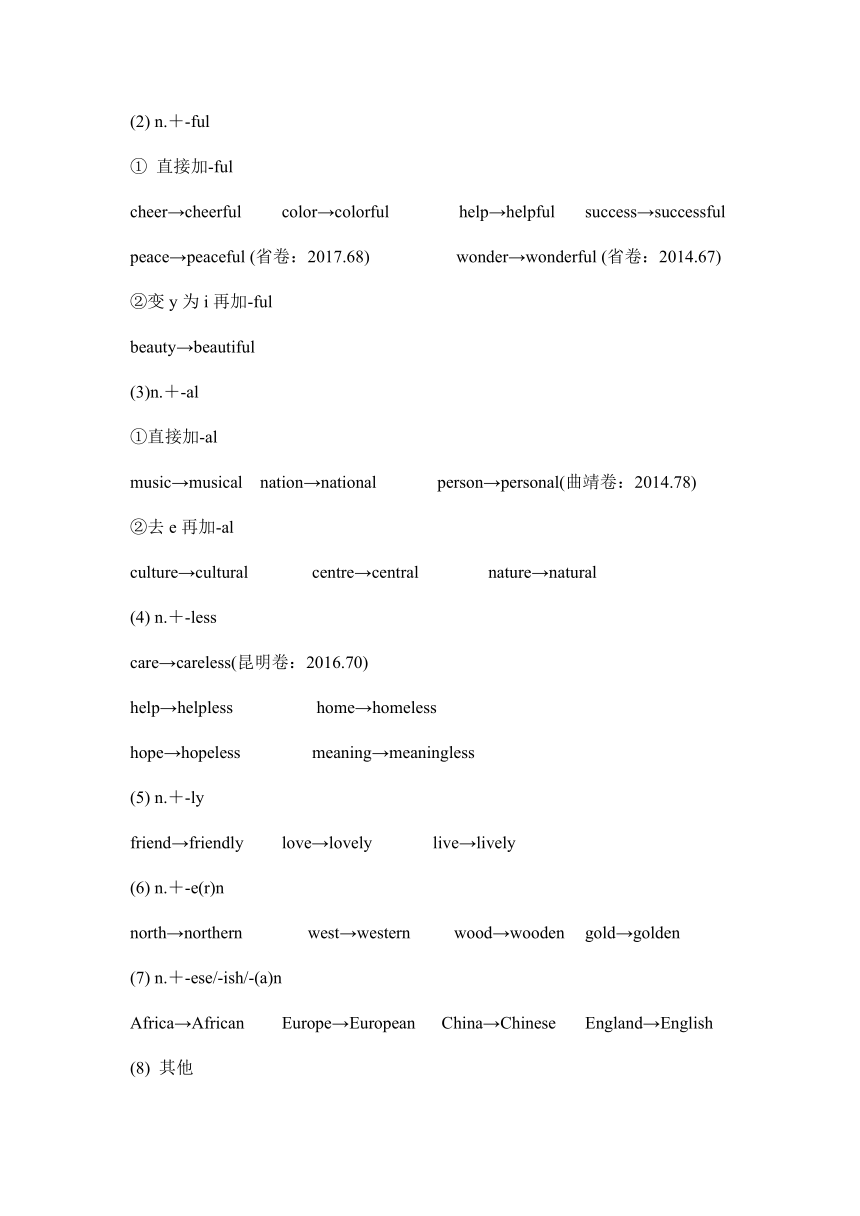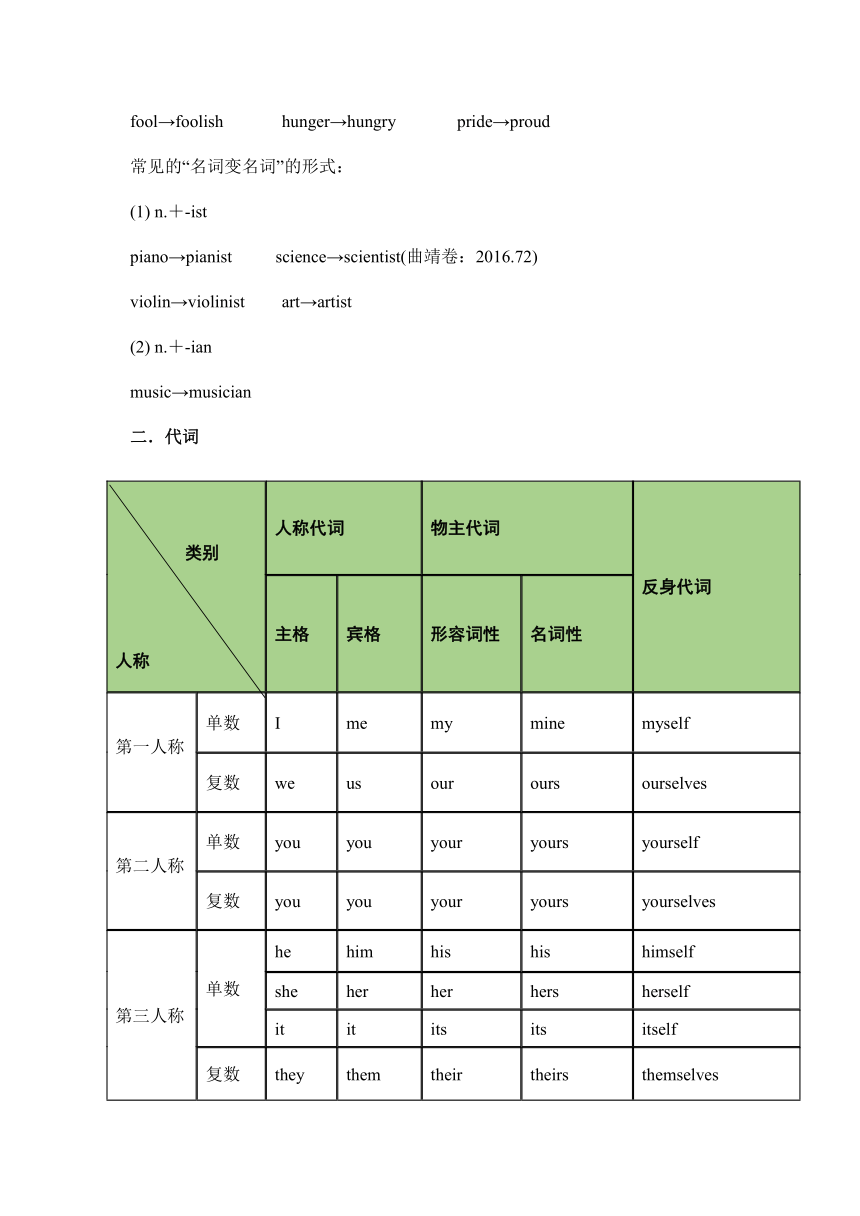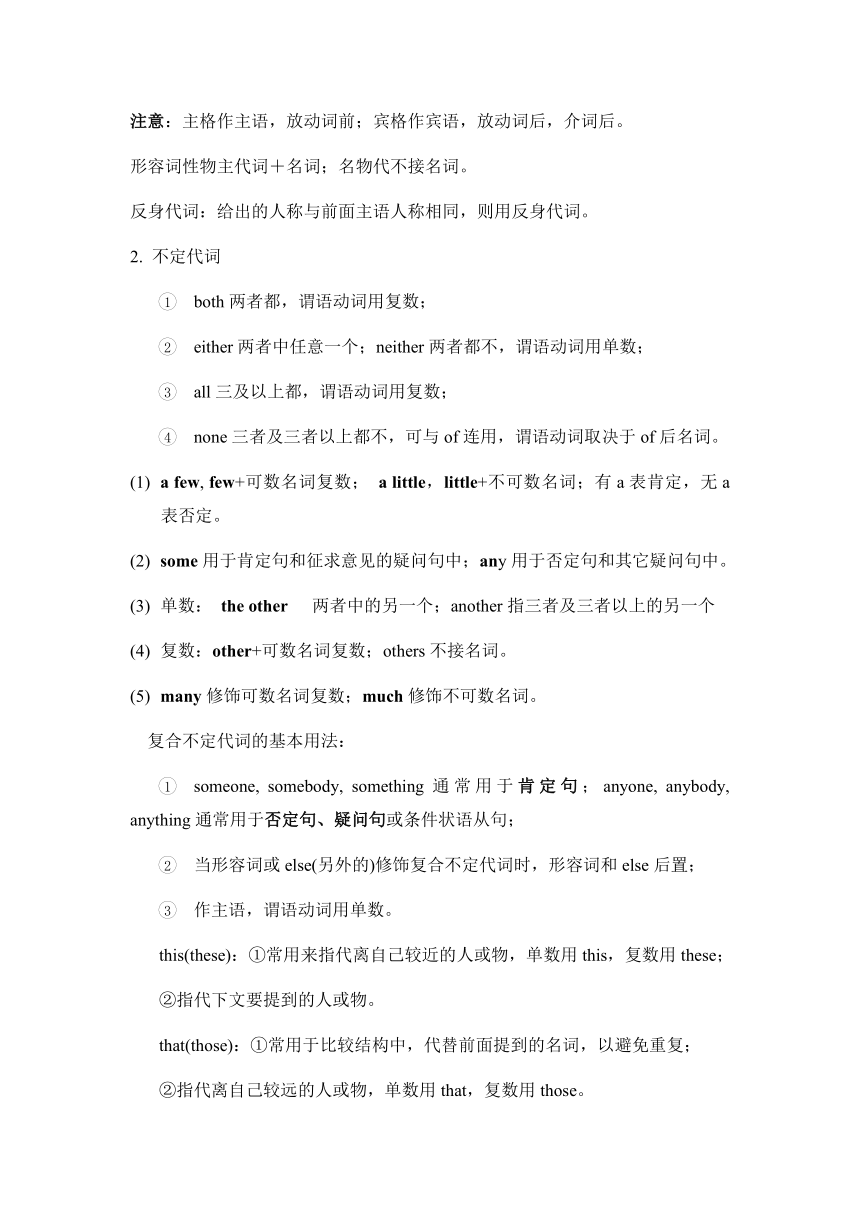2021年中考英语语法知识点总结(精简)(word版)
文档属性
| 名称 | 2021年中考英语语法知识点总结(精简)(word版) |  | |
| 格式 | docx | ||
| 文件大小 | 53.2KB | ||
| 资源类型 | 教案 | ||
| 版本资源 | 通用版 | ||
| 科目 | 英语 | ||
| 更新时间 | 2021-12-24 10:47:00 | ||
图片预览





文档简介
英语知识点总结
名词
可数名词,即可以用数字来进行计算的名词。
可数名词单数的前面一般用a/an来修饰,表示一个、一本、一张、一只等意义。
可数名词的复数表示两个、三本、四张、十只等意义。
可数名词复数的规则变化:
一般情况,加-s
以辅音字母加- y结尾的名词,先变y为i,再加 es
以字母-s, x, sh, ch等结尾的名词,加-es
以-o结尾的词,表示有生命的加-es;表示无生命的加 s
以字母 f或 fe结尾的名词,变f或fe为v,再加-es
改a为e型:man→men woman→women
变man为men(复合名词):a Frenchman→two Frenchmen
特例:German→Germans human→humans
改oo为ee型,tooth→teeth foot→feet
单复数形式相同:sheep→sheep deer→deer
常用作复数形式或只有复数形式:noodles; glasses; trousers;thanks; clothes; chopsticks; people
其他特殊形式:a child→two children a mouse→two mice
man和woman作定语时,其本身的单复数形式要与被修饰词的单复数一致。
a man teacher→men teachers(男老师)
a woman cook→women cooks(女厨师)
不可数名词,没有单复数形式,不能用冠词a/an。
名词所有格
以 s结尾的复数名词加’;the students’ eyes
不以 s结尾加’s, women’s work
表示几个人共同拥有,在最后一个人名后加’s
表示每个人各自拥有,在每个人名后分别加’s
of所有格
当限定词与名词所有格同时修饰一个名词时,要用双重所有格,即:限定词+名词+of+表示人的所有格/名词性物主代词。如:
a book of Jack’s 杰克的一本书 a blouse of mine我的一件衬衣
of前的名词是photo, picture等时,双重所有格与of所有格表示的意义不同。
a photo of Mary 玛丽本人的照片
a photo of Mary’s 玛丽许多照片中的一张(照片不一定是玛丽本人)
初中常考的“名词变形容词”的形式:
(1) n.+ y
① 直接加 y
health→healthy luck→lucky rain→rainy sleep→sleepy
wind→windy snow→snowy(省卷:2016.70)
② 双写末尾字母再加 y
fun→funny fog→foggy sun→sunny(曲靖卷:2015.76)
③ 去结尾e再加 y
noise→noisy taste→tasty
(2) n.+ ful
① 直接加 ful
cheer→cheerful color→colorful help→helpful success→successful
peace→peaceful (省卷:2017.68) wonder→wonderful (省卷:2014.67)
②变y为i再加 ful
beauty→beautiful
(3)n.+ al
①直接加 al
music→musical nation→national person→personal(曲靖卷:2014.78)
②去e再加 al
culture→cultural centre→central nature→natural
(4) n.+ less
care→careless(昆明卷:2016.70)
help→helpless home→homeless
hope→hopeless meaning→meaningless
(5) n.+ ly
friend→friendly love→lovely live→lively
(6) n.+ e(r)n
north→northern west→western wood→wooden gold→golden
(7) n.+ ese/ ish/ (a)n
Africa→African Europe→European China→Chinese England→English
(8) 其他
fool→foolish hunger→hungry pride→proud
常见的“名词变名词”的形式:
(1) n.+ ist
piano→pianist science→scientist(曲靖卷:2016.72)
violin→violinist art→artist
(2) n.+ ian
music→musician
类别 人称 人称代词 物主代词 反身代词
主格 宾格 形容词性 名词性
第一人称 单数 I me my mine myself
复数 we us our ours ourselves
第二人称 单数 you you your yours yourself
复数 you you your yours yourselves
第三人称 单数 he him his his himself
she her her hers herself
it it its its itself
复数 they them their theirs themselves
代词
注意:主格作主语,放动词前;宾格作宾语,放动词后,介词后。
形容词性物主代词+名词;名物代不接名词。
反身代词:给出的人称与前面主语人称相同,则用反身代词。
不定代词
both两者都,谓语动词用复数;
either两者中任意一个;neither两者都不,谓语动词用单数;
all三及以上都,谓语动词用复数;
none三者及三者以上都不,可与of连用,谓语动词取决于of后名词。
a few, few+可数名词复数; a little,little+不可数名词;有a表肯定,无a表否定。
some用于肯定句和征求意见的疑问句中;any用于否定句和其它疑问句中。
单数: the other 两者中的另一个;another指三者及三者以上的另一个
复数:other+可数名词复数;others不接名词。
many修饰可数名词复数;much修饰不可数名词。
复合不定代词的基本用法:
someone, somebody, something通常用于肯定句;anyone, anybody, anything通常用于否定句、疑问句或条件状语从句;
当形容词或else(另外的)修饰复合不定代词时,形容词和else后置;
作主语,谓语动词用单数。
this(these):①常用来指代离自己较近的人或物,单数用this,复数用these;
②指代下文要提到的人或物。
that(those):①常用于比较结构中,代替前面提到的名词,以避免重复;
②指代离自己较远的人或物,单数用that,复数用those。
it特指上下文提到的对象是同一事物(同类同物);
one泛指上下文提及的同类事物中的一个(同类异物)。
it的常用句型:
①It is+adj.+(for sb.)to do sth.(对某人来说)做某事是怎么样的(形容词形容做的事)
It is+adj.+(of sb.)to do sth (形容词形容人)
②It takes/took sb.some time/money to do sth.做某事花费某人多少时间/金钱。
作形式宾语:常用在动词find, think, make, consider, feel等词后。
冠词
a用在以辅音读音开头的单数可数名词前;an用在以元音读音开头的单数可数名词前。
注意:an honest person/an hour(h不发音)
The:
特指;特指上文已提过的人或事物;
用在双方都知道的人或事物;
世界上独一无二的事物前;
用在序数词前和形容词的最高级前;
西洋乐器前;
The+adj表示一类人或事物。
数词
基数词变序数词:一(first)、二(second)、三(third)特殊记,从4起th,8去t,9去e,ve用f替,y变ie,th,几十几只需变个位就可以。
基数词+hundred/thousand/million/billion;hundreds/thousands/millions/billions of(有基数词,无s,无of)
介词
时间介词:on+具体某一天(或早、中、晚);in+世纪、年、月、季节,或+一段时间(表示将来,在多久之后);at+时间点、noon/night/Christmas
方式介词(用,通过):on后接通讯工具或电子稿;with+具体工具/one's+身体部位;by+v-ing/交通工具;in+语言/颜色
besides除了……还有(包含);except除……之外(不包含);but除……之外(常与none/nothing/nobody连用)
among在……之中(三者或三者以上);between在(两者)……之间。
without没有,反义词with有,伴随,和
against反对,倚靠着;behind在……后面;beside 在……旁边
连词
but“但是”, 表转折;and“和”,表并列或顺承;or“或者,否则”,表选或条件;so“所以”, 表因果。
not only...but also... 不但……而且……;neither...nor...既不……也不……;either...or... 或者……或者……,并列主语,谓语动词用“就近原则”。
both...and...两者都……,谓语动词用复数形式。
when “当……时候”。从句用一般过去时,主句用过去的某种时态(一般过去时/过去进行时);
while “正当……时”,while引导的从句中,常用进行时;
As“当...时,一边...,一边...”
since“自从”,主句用现在完成时,从句用一般过去时(扩展:还有“既然”之意)
until “直到……”。常用not...until...,表示“直到……才……”(主祈从现/主将从现/主情从现);此用法连词有:if(如果)、unless(除非)、as long as(只要)、as soon as(一...就...)、when(当...时)
though、although、even though/if 虽然;尽管,不能与but连用。
so that /in order that以便,为了+句子;in order to+V原
So+adj/adv that+句子;such+(a/an)+adj+名词 that+句子
(备注:名前such,形副so,many/much/few/little用so)
七、形容词/副词
形容词修饰n,放系动词后;副词修v,副还修形容词/副词/句子。
原级:as/so+原级+as
比较级:关键词than;比较级and比较级(注意:多音节单词more and more+原级)表示越来越...;the+比较级...,the+比较级...,表示越...就越...
最高级:one of+the最高级+可数名词复数 最....之一
The+序数词+最高级+可数名词单数 第几最....
原级 比较级 最高级
good/well better best
ill/bad/badly worse worst
many/much more most
little less least
far farther/further farthest/furthest
old older/elder oldest/eldest
常见形容词变副词:
adj.+ ly
polite→politely different→differently real→really safe→safely
brave→bravely careful→carefully clear→clearly slow→slowly
quick→quickly recent→recently usual→usually
(2) 变y为i+ ly
easy→easily happy→happily healthy→healthily heavy→heavily
(3) 去e+ y
gentle→gently possible→possibly probable→probably simple→simply
(4) 去e+ ly
true→truly
八、动词
“借”: borrow 借进borrow sth. from sb;lend借出lend sth. to sb;keep借多久(延续性动词)
到达:get to+地点名词;reach +地点;arrive in+大地点(名词),at+小地点(名词)[备注:后接地点副词home、there、here、where不用介词]
穿:dress dress sb. 给某人穿衣服,dress sb. up 打扮某人;穿上,戴上,表示动作;wear穿着,戴着,表示状态
花费:spend人作主语,表示花费时间或金钱,后接on sth. 或(in) doing sth;
take :It+takes/took+一段时间+to do sth;cost物作主语;pay与for连用
看:see“看见”,表示结果;look“看”,表示动作,需与at连用;watch“观看(比赛、电视等)”;read“看(书、报、杂志等)”
说:speak 说语言,说话;say+说的内容;talk+to/with和...交谈 /+about交流
拿:bring“带来,拿来”;take“拿去,带走”;carry“扛,搬”;get“去取,去拿”,表示往返拿东西
系动词:+形容词
常见系动词:be,keep, stay, remain,become, turn,sound(听起来),look(看起来),taste(尝起来),smell(闻起来),feel(感觉,摸起来)
动词变名词:
v.+ er(or/r)
act→actor collect→collector dance→dancer design→designer
drive→driver help→helper listen→listener love→lover
manage→manager paint→painter play→player read→reader
report→reporter run→runner sing→singer sleep→sleeper
speak→speaker teach→teacher wait→waiter win→winner
work→worker write→writer
(2) v.+ ment
achieve→achievement agree→agreement enjoy→enjoyment develop→development excite→excitement improve→improvement
(3) v.+ ion/tion/sion或去e+ ion/tion/ation
collect→collection discuss→discussion direct→direction educate→education invent→invention pollute→pollution
(4) v.+ ing或双写末尾字母+ ing
begin→beginning build→building feel→feeling
mean→meaning meet→meeting swim→swimming
(5) 其他
choose→choice die→death fail→failure weigh→weight
动词变形容词:
(1) v.+ d/ ed/ ing或去e+ ing
amaze→amazed/amazing bore→bored/boring excite→excited/exciting
interest→interested/interesting please→pleased/pleasing
relax→relaxed/relaxing surprise→surprised/surprising
(2) v.+ able
accept→acceptable enjoy→enjoyable change→changeable
(3) v.+ ive或去e+ ive
act→active create→creative
(4) 其他
die→dead wake→awake sleep→asleep
情态动词+动词原形
Can表示能力,意为“能、会”,可与be able to互换
must 必须,一般疑问句用needn't/don't have to回答
have to不得不”,多表示客观必要。
may 可以,其疑问句回答用can,can't/mustn't(禁止)
should应该,表示要求和命令,也可以表示劝告或建议,shouldn’t不应该。
need需要,主要用于否定句和疑问句中,need的否定形式,意为“不必,无需”,其一般疑问句肯定回答用must。
表请求:can、could、may
表推测:must(一定)、may/might/could/can(可能)、can't(不可能)
十、非谓语动词
(一)动词不定式:to do或不带to,否定结构为not to do sth.
常见直接动词不定式的动词:
agree 同意 afford 负担 choose 选择 dare 敢于 decide 决定 expect 期望 help 帮助 hope 希望
manage 完成 offer 提供 plan 计划 prepare 准备
promise 许诺 refuse 拒绝 want 想要 wish 希望
常见用于接sb to do的动词有:
advise建议 allow允许 ask请求 encourage鼓励 expect期望
invite邀请 tell告诉 want想要 wish希望
省略to :let/ make sb do sth(注:变被动还原to)
动词不定式表目的(为了),表原因(因...)
动词不定式作后置定语(做...的...)eg:a good way to study English
动词不定式的特殊句型:
It is +adj.+of/for sb. to do sth. 意为“某人做某事是……/对某人来说做某事……”
used to do意为“过去常常……”
too+adj./adv.+to do sth. 意为“太……以至于不能……”
It’s one’s turn to do sth. 意为“轮到某人做某事了”
It takes/took sb. some time to do sth. 意为“某人花多长时间做某事”
adj./adv.+enough to do sth. 意为“足够……做……”。
常见省略to的不定式的句型:
had better (not) do sth.
would rather do sth. than do sth.
prefer to do sth. rather than do sth.
Why not do sth.?=Why don’t you do sth.?
Could/Would/Will you please (not) do sth.?
动名词:doing否定not doing
动名词作主语,谓语动词用三单
常见后直接v-ing的动词:
avoid 避免 enjoy 喜欢 keep 保持 suggest 建议
finish 完成 feel like 想要 practise 练习 mind 介意
常见接动名词的词组有:
have fun doing sth.做某事很开心 be busy doing sth.忙于做某事
be worth doing sth.值得做某事
to为介词: be/get/become used to习惯 look forward to 盼望;期待
pay attention to 注意 stick to 坚持 hold on to坚持;抓住
可接动词不定式又可接动名词,但表达的意义不同:
hear/see sb. doing sth.听见/看见某人正在做某事
hear/see sb. do sth.听见/看见某人做了某事 (全过程)
remember doing sth.记得做过某事
remember to do sth.记得要去做某事(未做)
forget doing sth. 忘了做过某事
forget to do sth. 忘了去做某事(未做)
stop doing sth.停止做某事
stop to do sth.停下来去做另外一件事
need doing sth. 需要做某事(被动含义)
need to do sth. 需要去做某事(主动含义)
try doing sth.尝试做某事
try to do sth.尽力做某事
分词:现在分词v-ing表主动,进行;过去分词v-ed表被动,完成(少考)
十一、六大基本时态
1.一般现在时:经常,习惯性动作,客观事实
主语+be动词(am/is/are)+其他
主语+实义动词原形/第三人称单数+其他
时间标志词:often,sometimes,usually,always,on Sundays,every day/week/month/year等。
2.一般过去时:过去的动作或状态
主语+be动词(was/were)+其他
主语+实义动词过去式(v-ed)+其他
时间标志词:yesterday, just now,two days ago, last night/week/month/year等。
一般将来时:将来、将来的动作或存在的状态
主语+will/shall +动词原形+其他
主语+be going to+动词原形+其他
时间标志词:tomorrow, in the future, soon,this evening,next week/month/term/year 等。
(备注:祈使句+and/or+含有将来时的句子。)
现在进行时:此刻正在发生的动作
主语+am/is/are+v. ing形式
标志词:now,at the moment ,Look / Listen
过去进行时:过去某个时刻正在进行的动作
主语+was/were+v. ing形式
标志词:at that time, this time yesterday, at 7:00 last night, at that moment等。
现在完成时:①过去发生或已经完成的动作,对现在造成的影响或结果;
②发生在过去的动作,延续到现在,并可能继续进行下去。
主语+has/have+动词的过去分词
标志词:already,yet,ever,so far,before ,in the past years,for+时间段或since+时间点/从句等
句中含since/for标志词短暂性动词需变延续性动词
buy→have borrow→keep leave→be away from
die→be dead become→be come to→be in
begin→be on stop→be over open/close→be open/closed
leave+地点→be away from+地点
被动语态(be+动词过去分词):标志词by,先判断主语与谓语动词的关系主动还是被动,其次判断时态。
简单句
五大基本句型(帮助写作文)
句型一:主语+系动词+表语
句型二:主语+不及物动词
句型三:主语+及物动词+宾语
句型四:主语+及物动词+间接宾语+直接宾语
句型五:主语+及物动词+宾语+宾语补足语
(一)陈述句:(陈述事实)肯定句/否定句
(二)一般疑问句:be/do did/does/have/has/will/情态动词置于句首,回答用yes或no(句首是谁就用谁回答)
(三)特殊疑问句
what什么,询问职业、身份或事、物
who谁,询问身份,人物
which哪一个,询问特定的人、物或事情
when什么时候,询问时间
where哪里,询问地点、位置
why为什么,询问原因
how怎样,询问方式
how often多久一次,提问频率
how far多远,提问距离
how long多长(时间),回答about/for+一段时间
how soon多久以后,回答用in+一段时间
how much多少(钱);多少(数量)+不可数名词
how many多少+可数名词复数
how old多大,提问年龄
how come为什么呢;怎么会呢,提问原因
(四)选择疑问句:提供两种或两种以上的情况供对方选择一种情况回答的疑问句,不能用yes或no回答
(五)反意疑问句:陈述句,+疑问部分(助动词/情态动词/be动词+主语)?
“三同一反”原则 即:人称相同、动词相同、时态相同、前肯后否或前否后肯。
注意:陈述部分中含否定词(no、nothing、nobody、none、hardly/seldom、few、little等),后需要肯定形式。
记:Let’s+祈使句, shall we?
祈使句,will you?(肯定/否定都用will you)
回答:根据陈述句事实回答,事实为肯定用yes,事实为否定用no(备注:前否后肯回答yes意思为“不”,no意思为“是的”)
(六)感叹句(排除主谓,看前有名词用what,无名词用how,可数名词单数用a/an,无how a/an)
What+ a/an+形容词+可数名词单数(+主语+谓语)!
What+形容词+可数名词复数/不可数名词(+主语+谓语)!
How+形容词/副词+(主语+谓语!)
How+主语+谓语!
倒装句:
so+助动词/情态动词/be动词+主语,意为“某某也是如此”(主语与上文主语同一个)
neither+助动词/情态动词/be动词+主语,意为“某某也不……”(主语与上文主语同一个)
强调句:so+主语+助动词/情态动词/be动词,意为“某某的确如此”(主语与上文不是同一个)
祈使句:
肯定:(Please+)动词原形+其他(省略主语you)
否定:Don't+V原 或No+v-ing/n
there be句型:表示某地有某物,其后主语并列,be用就近原则(见there就应想到be)
There is/are(not)...(一般现在时)
There was/were(not)...;There used be...(一般过去时)
There will(not) be.../There is /are(not) going to be...(一般将来时)
There have/has(not) been...(现在完成时)
备注:一般疑问句就用there回答
there be sb. doing sth.+地点/时间。某地/某时有某人正在做某事。
(区分:have/has表示某人拥有某物)
主谓一致
动名词作主语,谓语动词用单数
the number of+可数名词复数,谓语动词用单数;a number of+可数名词复数,谓语动词用复数;
主语后有with,except,besides,but,including,as well as+sb/sth,谓语动词取决于主语(就前原则);
分数或百分数+名词,谓语动词取决于名词;
集体名词(如:family/class/ team/group/等),取决于主语意义;作成员,用复数;作家庭/班级/队/组,用单数;
集合名词people/police等,谓语动词用复数;
the+某些形容词,表示一类人,谓语动词用复数;
时间、金钱、长度、价格作主语,谓语动词用单数;
and连接并列主语,表示同一个人或物时(即and后面无冠词)
复合句
宾语从句:位于动词、介词的从句叫作宾语从句
三要素:(1)语序 陈述语序, 即“连接词+主语+谓语+其他部分”
(2)连接词 :①that无实际意义可以省略;
②whether或if,是否;引导一般疑问语气;
(只能用whether:与or not连用;后接+to do;介词后)
③特殊疑问词(组):what, when, where, how,who,whom, whose, which, why, how many, how much, how long, how old, how often等。(根据回答来选择疑问词)
(备注:特殊疑问词+to do)
(3)时态:主现从不限;主过从也过;从句表达客观真理,不论主句什么时态,从句都用一般现在时。
注意:what's the matter /what's wrong with sb/sth?;what happened/is happening?本身就为陈述语序,作宾语时语序不变。
扩展: 在宾语从句中,当主句的谓语动词为think, believe,suppose等时, 从句中表示否定意义的not应移到这些词之前,即“否定前移”。
定语从句
在复合句中,修饰某一名词或代词的从句叫作定语从句,定语从句置于它所修饰的名词或代词之后,被修饰的名词或代词叫作先行词。
先行词指人,关系词用that(主、宾)、who(主、宾)、whom(宾)、whose+名词;
先行词指物,关系词用that(主、宾)、which(主、宾)
(温馨提示:判断不来时,有that就选that)
只用that的情况:
先行词是不定代词(something、all、some等);
当先行词既有人又有物时;
先行词前有序数词或形容词最高级修饰,或先行词本身就是序数词时
十五、情景交际(听力第6-10题;单选至少3题)
(1)问近况:How are you?/How’s everything / How is it going (with you)
回答:Pretty good. /terrible/just so-so...
(2)感谢:Thanks a lot./Many thanks./Thank you all the same.(同时很感谢你)
It’s nice of you to.../ It’s very kind of you.
回答:It’s a/my pleasure./My pleasure. /That’s all right./You’re welcome.
Not at all./Don’t mention it.
(3)邀请:Can you.. Would you like to do sth.
回答:①同意Yes, I’d like/love to./Yes, I’ll be glad to. /Sure, catch you on...
②Sorry, I’m afraid not./Sorry, I’m afraid I can’t.
It’s very nice of you, but my mother is ill.
I’d love to, but I’m afraid I have no time.
I’m sorry I can’t. What about another time?
注意:①Would you like sth.
Yes,please/No,thanks
②Would you mind (if)...
不介意:Not at all. /No, not at all./of course/certain not
介意:You’d better not /of course
(4)请求、允许:May/could I .../Would you please...
回答:①肯定Yes./Sure. /Certainly./Of course, /No problem. /That’s OK./All right. /Go ahead(请便)/With pleasure.
②否定I’m sorry, you can’t./No, you /can’t/mustn’t(禁止)
/I’m afraid not
建议: You should (not) do sth./Why don’t you /Why not do sth.
How/What about doing sth. /Shall we...?/Let’s..., shall we
回答:Good idea! sounds wonderful/great/That’s a good idea.
Sorry,I'm afraid not.../I’d love to, but...
(6)祝贺祝愿:Have a good trip/day/time/journey!/Enjoy yourself!
(别人说去旅游、度假)
Congratulations!(别人取得好成绩,赢得比赛)
Wish you good luck/all success. (别人参加比赛、考试)
Thank you. (别人赞美、夸奖时回答)
(7)打电话:Hello! Could/May I speak to John /Is John in
Is that John speaking /I’d like to speak to John.
①接电话人的回答:
Hello! This is John speaking./Yes, speaking please. /Who’s that speaking
②非接电话人的回答:
Hold on(a moment)./Hold the line/A moment, please.
Sorry, he(she)is not in. Can I take a message for you
(8)就餐:May I take your order /Would you like something to eat/drink
回答①肯定Yes, I’d like a cup of coffee./I’d like rice and chicken./
Just a little, please.
②否定No. Thanks/Thank you. /I’ve had enough./I’m full, thank you.
就医:
①医生诊断常用语:
What’s the mater /How long have you felt like this
It’s nothing serious./Take this medicine three times a day.
You’ll be all right/well soon.
②病人叙述病情常用语:
I feel terrible/bad./I don’t feel well.
There’s something wrong with my eyes./I can’t sleep well
购物:
①售货员常用语:
Can/May I help you /What can I do for you
②顾客常用语:
I want/I’d like a pair of shoes.
Just have a look.
警告和禁止
You can’t do that. /Don’t walk there.../Never try to do...
回答:Sorry, I won’t do that again./OK,I won't
肯定祈使句: Look out!/Be careful!/remember...
回答:OK,I will/I got it
判断与评价
what do you think of... /How do you like...
回答:I love/like...(very much). /I don’t love/like... /I can’t stand them.
观点看法:I think..../Do you think...
回答:不赞同I guess so.../Yes, I think so./I agree with you.
赞同I don’t think so./ I don’t agree.
安慰..feel nervous----回答Take it easy
道歉I’m sorry /so sorry..
回答:It doesn’t matter./that's all right./it doesn't matter/not at all/Never mind
询问长相
What does sb. look like
回答:He is tall/short... / has big eyes/black hair...
What is sb. like (性格)
回答:she/he is kind/friendly
What does sb like?(喜好)
询问时间
what's the date today?(日期)
what day is it today?(星期)
What time is it?(时间点)
名词
可数名词,即可以用数字来进行计算的名词。
可数名词单数的前面一般用a/an来修饰,表示一个、一本、一张、一只等意义。
可数名词的复数表示两个、三本、四张、十只等意义。
可数名词复数的规则变化:
一般情况,加-s
以辅音字母加- y结尾的名词,先变y为i,再加 es
以字母-s, x, sh, ch等结尾的名词,加-es
以-o结尾的词,表示有生命的加-es;表示无生命的加 s
以字母 f或 fe结尾的名词,变f或fe为v,再加-es
改a为e型:man→men woman→women
变man为men(复合名词):a Frenchman→two Frenchmen
特例:German→Germans human→humans
改oo为ee型,tooth→teeth foot→feet
单复数形式相同:sheep→sheep deer→deer
常用作复数形式或只有复数形式:noodles; glasses; trousers;thanks; clothes; chopsticks; people
其他特殊形式:a child→two children a mouse→two mice
man和woman作定语时,其本身的单复数形式要与被修饰词的单复数一致。
a man teacher→men teachers(男老师)
a woman cook→women cooks(女厨师)
不可数名词,没有单复数形式,不能用冠词a/an。
名词所有格
以 s结尾的复数名词加’;the students’ eyes
不以 s结尾加’s, women’s work
表示几个人共同拥有,在最后一个人名后加’s
表示每个人各自拥有,在每个人名后分别加’s
of所有格
当限定词与名词所有格同时修饰一个名词时,要用双重所有格,即:限定词+名词+of+表示人的所有格/名词性物主代词。如:
a book of Jack’s 杰克的一本书 a blouse of mine我的一件衬衣
of前的名词是photo, picture等时,双重所有格与of所有格表示的意义不同。
a photo of Mary 玛丽本人的照片
a photo of Mary’s 玛丽许多照片中的一张(照片不一定是玛丽本人)
初中常考的“名词变形容词”的形式:
(1) n.+ y
① 直接加 y
health→healthy luck→lucky rain→rainy sleep→sleepy
wind→windy snow→snowy(省卷:2016.70)
② 双写末尾字母再加 y
fun→funny fog→foggy sun→sunny(曲靖卷:2015.76)
③ 去结尾e再加 y
noise→noisy taste→tasty
(2) n.+ ful
① 直接加 ful
cheer→cheerful color→colorful help→helpful success→successful
peace→peaceful (省卷:2017.68) wonder→wonderful (省卷:2014.67)
②变y为i再加 ful
beauty→beautiful
(3)n.+ al
①直接加 al
music→musical nation→national person→personal(曲靖卷:2014.78)
②去e再加 al
culture→cultural centre→central nature→natural
(4) n.+ less
care→careless(昆明卷:2016.70)
help→helpless home→homeless
hope→hopeless meaning→meaningless
(5) n.+ ly
friend→friendly love→lovely live→lively
(6) n.+ e(r)n
north→northern west→western wood→wooden gold→golden
(7) n.+ ese/ ish/ (a)n
Africa→African Europe→European China→Chinese England→English
(8) 其他
fool→foolish hunger→hungry pride→proud
常见的“名词变名词”的形式:
(1) n.+ ist
piano→pianist science→scientist(曲靖卷:2016.72)
violin→violinist art→artist
(2) n.+ ian
music→musician
类别 人称 人称代词 物主代词 反身代词
主格 宾格 形容词性 名词性
第一人称 单数 I me my mine myself
复数 we us our ours ourselves
第二人称 单数 you you your yours yourself
复数 you you your yours yourselves
第三人称 单数 he him his his himself
she her her hers herself
it it its its itself
复数 they them their theirs themselves
代词
注意:主格作主语,放动词前;宾格作宾语,放动词后,介词后。
形容词性物主代词+名词;名物代不接名词。
反身代词:给出的人称与前面主语人称相同,则用反身代词。
不定代词
both两者都,谓语动词用复数;
either两者中任意一个;neither两者都不,谓语动词用单数;
all三及以上都,谓语动词用复数;
none三者及三者以上都不,可与of连用,谓语动词取决于of后名词。
a few, few+可数名词复数; a little,little+不可数名词;有a表肯定,无a表否定。
some用于肯定句和征求意见的疑问句中;any用于否定句和其它疑问句中。
单数: the other 两者中的另一个;another指三者及三者以上的另一个
复数:other+可数名词复数;others不接名词。
many修饰可数名词复数;much修饰不可数名词。
复合不定代词的基本用法:
someone, somebody, something通常用于肯定句;anyone, anybody, anything通常用于否定句、疑问句或条件状语从句;
当形容词或else(另外的)修饰复合不定代词时,形容词和else后置;
作主语,谓语动词用单数。
this(these):①常用来指代离自己较近的人或物,单数用this,复数用these;
②指代下文要提到的人或物。
that(those):①常用于比较结构中,代替前面提到的名词,以避免重复;
②指代离自己较远的人或物,单数用that,复数用those。
it特指上下文提到的对象是同一事物(同类同物);
one泛指上下文提及的同类事物中的一个(同类异物)。
it的常用句型:
①It is+adj.+(for sb.)to do sth.(对某人来说)做某事是怎么样的(形容词形容做的事)
It is+adj.+(of sb.)to do sth (形容词形容人)
②It takes/took sb.some time/money to do sth.做某事花费某人多少时间/金钱。
作形式宾语:常用在动词find, think, make, consider, feel等词后。
冠词
a用在以辅音读音开头的单数可数名词前;an用在以元音读音开头的单数可数名词前。
注意:an honest person/an hour(h不发音)
The:
特指;特指上文已提过的人或事物;
用在双方都知道的人或事物;
世界上独一无二的事物前;
用在序数词前和形容词的最高级前;
西洋乐器前;
The+adj表示一类人或事物。
数词
基数词变序数词:一(first)、二(second)、三(third)特殊记,从4起th,8去t,9去e,ve用f替,y变ie,th,几十几只需变个位就可以。
基数词+hundred/thousand/million/billion;hundreds/thousands/millions/billions of(有基数词,无s,无of)
介词
时间介词:on+具体某一天(或早、中、晚);in+世纪、年、月、季节,或+一段时间(表示将来,在多久之后);at+时间点、noon/night/Christmas
方式介词(用,通过):on后接通讯工具或电子稿;with+具体工具/one's+身体部位;by+v-ing/交通工具;in+语言/颜色
besides除了……还有(包含);except除……之外(不包含);but除……之外(常与none/nothing/nobody连用)
among在……之中(三者或三者以上);between在(两者)……之间。
without没有,反义词with有,伴随,和
against反对,倚靠着;behind在……后面;beside 在……旁边
连词
but“但是”, 表转折;and“和”,表并列或顺承;or“或者,否则”,表选或条件;so“所以”, 表因果。
not only...but also... 不但……而且……;neither...nor...既不……也不……;either...or... 或者……或者……,并列主语,谓语动词用“就近原则”。
both...and...两者都……,谓语动词用复数形式。
when “当……时候”。从句用一般过去时,主句用过去的某种时态(一般过去时/过去进行时);
while “正当……时”,while引导的从句中,常用进行时;
As“当...时,一边...,一边...”
since“自从”,主句用现在完成时,从句用一般过去时(扩展:还有“既然”之意)
until “直到……”。常用not...until...,表示“直到……才……”(主祈从现/主将从现/主情从现);此用法连词有:if(如果)、unless(除非)、as long as(只要)、as soon as(一...就...)、when(当...时)
though、although、even though/if 虽然;尽管,不能与but连用。
so that /in order that以便,为了+句子;in order to+V原
So+adj/adv that+句子;such+(a/an)+adj+名词 that+句子
(备注:名前such,形副so,many/much/few/little用so)
七、形容词/副词
形容词修饰n,放系动词后;副词修v,副还修形容词/副词/句子。
原级:as/so+原级+as
比较级:关键词than;比较级and比较级(注意:多音节单词more and more+原级)表示越来越...;the+比较级...,the+比较级...,表示越...就越...
最高级:one of+the最高级+可数名词复数 最....之一
The+序数词+最高级+可数名词单数 第几最....
原级 比较级 最高级
good/well better best
ill/bad/badly worse worst
many/much more most
little less least
far farther/further farthest/furthest
old older/elder oldest/eldest
常见形容词变副词:
adj.+ ly
polite→politely different→differently real→really safe→safely
brave→bravely careful→carefully clear→clearly slow→slowly
quick→quickly recent→recently usual→usually
(2) 变y为i+ ly
easy→easily happy→happily healthy→healthily heavy→heavily
(3) 去e+ y
gentle→gently possible→possibly probable→probably simple→simply
(4) 去e+ ly
true→truly
八、动词
“借”: borrow 借进borrow sth. from sb;lend借出lend sth. to sb;keep借多久(延续性动词)
到达:get to+地点名词;reach +地点;arrive in+大地点(名词),at+小地点(名词)[备注:后接地点副词home、there、here、where不用介词]
穿:dress dress sb. 给某人穿衣服,dress sb. up 打扮某人;穿上,戴上,表示动作;wear穿着,戴着,表示状态
花费:spend人作主语,表示花费时间或金钱,后接on sth. 或(in) doing sth;
take :It+takes/took+一段时间+to do sth;cost物作主语;pay与for连用
看:see“看见”,表示结果;look“看”,表示动作,需与at连用;watch“观看(比赛、电视等)”;read“看(书、报、杂志等)”
说:speak 说语言,说话;say+说的内容;talk+to/with和...交谈 /+about交流
拿:bring“带来,拿来”;take“拿去,带走”;carry“扛,搬”;get“去取,去拿”,表示往返拿东西
系动词:+形容词
常见系动词:be,keep, stay, remain,become, turn,sound(听起来),look(看起来),taste(尝起来),smell(闻起来),feel(感觉,摸起来)
动词变名词:
v.+ er(or/r)
act→actor collect→collector dance→dancer design→designer
drive→driver help→helper listen→listener love→lover
manage→manager paint→painter play→player read→reader
report→reporter run→runner sing→singer sleep→sleeper
speak→speaker teach→teacher wait→waiter win→winner
work→worker write→writer
(2) v.+ ment
achieve→achievement agree→agreement enjoy→enjoyment develop→development excite→excitement improve→improvement
(3) v.+ ion/tion/sion或去e+ ion/tion/ation
collect→collection discuss→discussion direct→direction educate→education invent→invention pollute→pollution
(4) v.+ ing或双写末尾字母+ ing
begin→beginning build→building feel→feeling
mean→meaning meet→meeting swim→swimming
(5) 其他
choose→choice die→death fail→failure weigh→weight
动词变形容词:
(1) v.+ d/ ed/ ing或去e+ ing
amaze→amazed/amazing bore→bored/boring excite→excited/exciting
interest→interested/interesting please→pleased/pleasing
relax→relaxed/relaxing surprise→surprised/surprising
(2) v.+ able
accept→acceptable enjoy→enjoyable change→changeable
(3) v.+ ive或去e+ ive
act→active create→creative
(4) 其他
die→dead wake→awake sleep→asleep
情态动词+动词原形
Can表示能力,意为“能、会”,可与be able to互换
must 必须,一般疑问句用needn't/don't have to回答
have to不得不”,多表示客观必要。
may 可以,其疑问句回答用can,can't/mustn't(禁止)
should应该,表示要求和命令,也可以表示劝告或建议,shouldn’t不应该。
need需要,主要用于否定句和疑问句中,need的否定形式,意为“不必,无需”,其一般疑问句肯定回答用must。
表请求:can、could、may
表推测:must(一定)、may/might/could/can(可能)、can't(不可能)
十、非谓语动词
(一)动词不定式:to do或不带to,否定结构为not to do sth.
常见直接动词不定式的动词:
agree 同意 afford 负担 choose 选择 dare 敢于 decide 决定 expect 期望 help 帮助 hope 希望
manage 完成 offer 提供 plan 计划 prepare 准备
promise 许诺 refuse 拒绝 want 想要 wish 希望
常见用于接sb to do的动词有:
advise建议 allow允许 ask请求 encourage鼓励 expect期望
invite邀请 tell告诉 want想要 wish希望
省略to :let/ make sb do sth(注:变被动还原to)
动词不定式表目的(为了),表原因(因...)
动词不定式作后置定语(做...的...)eg:a good way to study English
动词不定式的特殊句型:
It is +adj.+of/for sb. to do sth. 意为“某人做某事是……/对某人来说做某事……”
used to do意为“过去常常……”
too+adj./adv.+to do sth. 意为“太……以至于不能……”
It’s one’s turn to do sth. 意为“轮到某人做某事了”
It takes/took sb. some time to do sth. 意为“某人花多长时间做某事”
adj./adv.+enough to do sth. 意为“足够……做……”。
常见省略to的不定式的句型:
had better (not) do sth.
would rather do sth. than do sth.
prefer to do sth. rather than do sth.
Why not do sth.?=Why don’t you do sth.?
Could/Would/Will you please (not) do sth.?
动名词:doing否定not doing
动名词作主语,谓语动词用三单
常见后直接v-ing的动词:
avoid 避免 enjoy 喜欢 keep 保持 suggest 建议
finish 完成 feel like 想要 practise 练习 mind 介意
常见接动名词的词组有:
have fun doing sth.做某事很开心 be busy doing sth.忙于做某事
be worth doing sth.值得做某事
to为介词: be/get/become used to习惯 look forward to 盼望;期待
pay attention to 注意 stick to 坚持 hold on to坚持;抓住
可接动词不定式又可接动名词,但表达的意义不同:
hear/see sb. doing sth.听见/看见某人正在做某事
hear/see sb. do sth.听见/看见某人做了某事 (全过程)
remember doing sth.记得做过某事
remember to do sth.记得要去做某事(未做)
forget doing sth. 忘了做过某事
forget to do sth. 忘了去做某事(未做)
stop doing sth.停止做某事
stop to do sth.停下来去做另外一件事
need doing sth. 需要做某事(被动含义)
need to do sth. 需要去做某事(主动含义)
try doing sth.尝试做某事
try to do sth.尽力做某事
分词:现在分词v-ing表主动,进行;过去分词v-ed表被动,完成(少考)
十一、六大基本时态
1.一般现在时:经常,习惯性动作,客观事实
主语+be动词(am/is/are)+其他
主语+实义动词原形/第三人称单数+其他
时间标志词:often,sometimes,usually,always,on Sundays,every day/week/month/year等。
2.一般过去时:过去的动作或状态
主语+be动词(was/were)+其他
主语+实义动词过去式(v-ed)+其他
时间标志词:yesterday, just now,two days ago, last night/week/month/year等。
一般将来时:将来、将来的动作或存在的状态
主语+will/shall +动词原形+其他
主语+be going to+动词原形+其他
时间标志词:tomorrow, in the future, soon,this evening,next week/month/term/year 等。
(备注:祈使句+and/or+含有将来时的句子。)
现在进行时:此刻正在发生的动作
主语+am/is/are+v. ing形式
标志词:now,at the moment ,Look / Listen
过去进行时:过去某个时刻正在进行的动作
主语+was/were+v. ing形式
标志词:at that time, this time yesterday, at 7:00 last night, at that moment等。
现在完成时:①过去发生或已经完成的动作,对现在造成的影响或结果;
②发生在过去的动作,延续到现在,并可能继续进行下去。
主语+has/have+动词的过去分词
标志词:already,yet,ever,so far,before ,in the past years,for+时间段或since+时间点/从句等
句中含since/for标志词短暂性动词需变延续性动词
buy→have borrow→keep leave→be away from
die→be dead become→be come to→be in
begin→be on stop→be over open/close→be open/closed
leave+地点→be away from+地点
被动语态(be+动词过去分词):标志词by,先判断主语与谓语动词的关系主动还是被动,其次判断时态。
简单句
五大基本句型(帮助写作文)
句型一:主语+系动词+表语
句型二:主语+不及物动词
句型三:主语+及物动词+宾语
句型四:主语+及物动词+间接宾语+直接宾语
句型五:主语+及物动词+宾语+宾语补足语
(一)陈述句:(陈述事实)肯定句/否定句
(二)一般疑问句:be/do did/does/have/has/will/情态动词置于句首,回答用yes或no(句首是谁就用谁回答)
(三)特殊疑问句
what什么,询问职业、身份或事、物
who谁,询问身份,人物
which哪一个,询问特定的人、物或事情
when什么时候,询问时间
where哪里,询问地点、位置
why为什么,询问原因
how怎样,询问方式
how often多久一次,提问频率
how far多远,提问距离
how long多长(时间),回答about/for+一段时间
how soon多久以后,回答用in+一段时间
how much多少(钱);多少(数量)+不可数名词
how many多少+可数名词复数
how old多大,提问年龄
how come为什么呢;怎么会呢,提问原因
(四)选择疑问句:提供两种或两种以上的情况供对方选择一种情况回答的疑问句,不能用yes或no回答
(五)反意疑问句:陈述句,+疑问部分(助动词/情态动词/be动词+主语)?
“三同一反”原则 即:人称相同、动词相同、时态相同、前肯后否或前否后肯。
注意:陈述部分中含否定词(no、nothing、nobody、none、hardly/seldom、few、little等),后需要肯定形式。
记:Let’s+祈使句, shall we?
祈使句,will you?(肯定/否定都用will you)
回答:根据陈述句事实回答,事实为肯定用yes,事实为否定用no(备注:前否后肯回答yes意思为“不”,no意思为“是的”)
(六)感叹句(排除主谓,看前有名词用what,无名词用how,可数名词单数用a/an,无how a/an)
What+ a/an+形容词+可数名词单数(+主语+谓语)!
What+形容词+可数名词复数/不可数名词(+主语+谓语)!
How+形容词/副词+(主语+谓语!)
How+主语+谓语!
倒装句:
so+助动词/情态动词/be动词+主语,意为“某某也是如此”(主语与上文主语同一个)
neither+助动词/情态动词/be动词+主语,意为“某某也不……”(主语与上文主语同一个)
强调句:so+主语+助动词/情态动词/be动词,意为“某某的确如此”(主语与上文不是同一个)
祈使句:
肯定:(Please+)动词原形+其他(省略主语you)
否定:Don't+V原 或No+v-ing/n
there be句型:表示某地有某物,其后主语并列,be用就近原则(见there就应想到be)
There is/are(not)...(一般现在时)
There was/were(not)...;There used be...(一般过去时)
There will(not) be.../There is /are(not) going to be...(一般将来时)
There have/has(not) been...(现在完成时)
备注:一般疑问句就用there回答
there be sb. doing sth.+地点/时间。某地/某时有某人正在做某事。
(区分:have/has表示某人拥有某物)
主谓一致
动名词作主语,谓语动词用单数
the number of+可数名词复数,谓语动词用单数;a number of+可数名词复数,谓语动词用复数;
主语后有with,except,besides,but,including,as well as+sb/sth,谓语动词取决于主语(就前原则);
分数或百分数+名词,谓语动词取决于名词;
集体名词(如:family/class/ team/group/等),取决于主语意义;作成员,用复数;作家庭/班级/队/组,用单数;
集合名词people/police等,谓语动词用复数;
the+某些形容词,表示一类人,谓语动词用复数;
时间、金钱、长度、价格作主语,谓语动词用单数;
and连接并列主语,表示同一个人或物时(即and后面无冠词)
复合句
宾语从句:位于动词、介词的从句叫作宾语从句
三要素:(1)语序 陈述语序, 即“连接词+主语+谓语+其他部分”
(2)连接词 :①that无实际意义可以省略;
②whether或if,是否;引导一般疑问语气;
(只能用whether:与or not连用;后接+to do;介词后)
③特殊疑问词(组):what, when, where, how,who,whom, whose, which, why, how many, how much, how long, how old, how often等。(根据回答来选择疑问词)
(备注:特殊疑问词+to do)
(3)时态:主现从不限;主过从也过;从句表达客观真理,不论主句什么时态,从句都用一般现在时。
注意:what's the matter /what's wrong with sb/sth?;what happened/is happening?本身就为陈述语序,作宾语时语序不变。
扩展: 在宾语从句中,当主句的谓语动词为think, believe,suppose等时, 从句中表示否定意义的not应移到这些词之前,即“否定前移”。
定语从句
在复合句中,修饰某一名词或代词的从句叫作定语从句,定语从句置于它所修饰的名词或代词之后,被修饰的名词或代词叫作先行词。
先行词指人,关系词用that(主、宾)、who(主、宾)、whom(宾)、whose+名词;
先行词指物,关系词用that(主、宾)、which(主、宾)
(温馨提示:判断不来时,有that就选that)
只用that的情况:
先行词是不定代词(something、all、some等);
当先行词既有人又有物时;
先行词前有序数词或形容词最高级修饰,或先行词本身就是序数词时
十五、情景交际(听力第6-10题;单选至少3题)
(1)问近况:How are you?/How’s everything / How is it going (with you)
回答:Pretty good. /terrible/just so-so...
(2)感谢:Thanks a lot./Many thanks./Thank you all the same.(同时很感谢你)
It’s nice of you to.../ It’s very kind of you.
回答:It’s a/my pleasure./My pleasure. /That’s all right./You’re welcome.
Not at all./Don’t mention it.
(3)邀请:Can you.. Would you like to do sth.
回答:①同意Yes, I’d like/love to./Yes, I’ll be glad to. /Sure, catch you on...
②Sorry, I’m afraid not./Sorry, I’m afraid I can’t.
It’s very nice of you, but my mother is ill.
I’d love to, but I’m afraid I have no time.
I’m sorry I can’t. What about another time?
注意:①Would you like sth.
Yes,please/No,thanks
②Would you mind (if)...
不介意:Not at all. /No, not at all./of course/certain not
介意:You’d better not /of course
(4)请求、允许:May/could I .../Would you please...
回答:①肯定Yes./Sure. /Certainly./Of course, /No problem. /That’s OK./All right. /Go ahead(请便)/With pleasure.
②否定I’m sorry, you can’t./No, you /can’t/mustn’t(禁止)
/I’m afraid not
建议: You should (not) do sth./Why don’t you /Why not do sth.
How/What about doing sth. /Shall we...?/Let’s..., shall we
回答:Good idea! sounds wonderful/great/That’s a good idea.
Sorry,I'm afraid not.../I’d love to, but...
(6)祝贺祝愿:Have a good trip/day/time/journey!/Enjoy yourself!
(别人说去旅游、度假)
Congratulations!(别人取得好成绩,赢得比赛)
Wish you good luck/all success. (别人参加比赛、考试)
Thank you. (别人赞美、夸奖时回答)
(7)打电话:Hello! Could/May I speak to John /Is John in
Is that John speaking /I’d like to speak to John.
①接电话人的回答:
Hello! This is John speaking./Yes, speaking please. /Who’s that speaking
②非接电话人的回答:
Hold on(a moment)./Hold the line/A moment, please.
Sorry, he(she)is not in. Can I take a message for you
(8)就餐:May I take your order /Would you like something to eat/drink
回答①肯定Yes, I’d like a cup of coffee./I’d like rice and chicken./
Just a little, please.
②否定No. Thanks/Thank you. /I’ve had enough./I’m full, thank you.
就医:
①医生诊断常用语:
What’s the mater /How long have you felt like this
It’s nothing serious./Take this medicine three times a day.
You’ll be all right/well soon.
②病人叙述病情常用语:
I feel terrible/bad./I don’t feel well.
There’s something wrong with my eyes./I can’t sleep well
购物:
①售货员常用语:
Can/May I help you /What can I do for you
②顾客常用语:
I want/I’d like a pair of shoes.
Just have a look.
警告和禁止
You can’t do that. /Don’t walk there.../Never try to do...
回答:Sorry, I won’t do that again./OK,I won't
肯定祈使句: Look out!/Be careful!/remember...
回答:OK,I will/I got it
判断与评价
what do you think of... /How do you like...
回答:I love/like...(very much). /I don’t love/like... /I can’t stand them.
观点看法:I think..../Do you think...
回答:不赞同I guess so.../Yes, I think so./I agree with you.
赞同I don’t think so./ I don’t agree.
安慰..feel nervous----回答Take it easy
道歉I’m sorry /so sorry..
回答:It doesn’t matter./that's all right./it doesn't matter/not at all/Never mind
询问长相
What does sb. look like
回答:He is tall/short... / has big eyes/black hair...
What is sb. like (性格)
回答:she/he is kind/friendly
What does sb like?(喜好)
询问时间
what's the date today?(日期)
what day is it today?(星期)
What time is it?(时间点)
